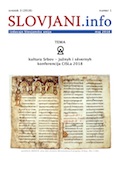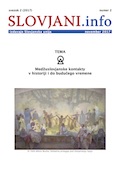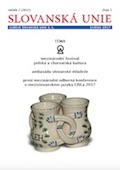

parametry poiskanja: avtor = %jan%, nazvanje = %jezyk%, rezjume = %, kljucno = %, od = 2016, do = 2999
(novo poiskanje jest na na koncu tutoj stranice)

PDF format |
Steenbergen van, J. Umětne jezyky i ISO 639-3 (in English: Constructed languages and ISO 639-3) in: Slovjani.info, 2018, 3(1), pages 52-68. ISSN 2570-7108 (print), ISSN 2570-7116 (on-line). Available from [https://slovjani.info]. rezjume: SIL International upravjaje medžunarodnym standardom ISO 639-3, v ktorom vsaky ljudsky jezyk imaje tribukvovy kod. Na spisu takože jest město dlja umětnyh jezykov, ale do časa postupanje s njimi bylo nedoslědno i te jezyky, ktore dnes sut na spisu, byli izbrane dost slučajno. Največši problem jest odsučstvo jasnyh, praktičnyh kriterijev, ktore sut prigodne dlja svojstv toj kategorije jezykov. Zato avtor prědlagaje četyri konkretne, měrime kriterije vključenja. V vtoroj česti članka avtor takože obgovarjaje možnosti priznanja koda medžuslovjanskomu jezyku. ključne slova: ISO 639-3; SIL; umětne jezyky; medžuslovjansky summary: Although SIL explicitly states the intention to assign ISO 639-3 codes to constructed languages as well, the criteria it applies for inclusion are very unclear, and mostly pertaining to natural languages. The 21 constructed languages that currently have a code appear to have been selected rather haphazardly, and half of them do not even fulfil the criteria. Besides, there is little consistency in the arguments used for turning down change requests. Constructed languages have characteristics that require a specific approach, which until now SIL has been unable to provide. To cope with this problem, the author proposes four measurable criteria: completeness, literature, community and notability. Two additional factors, uniqueness and permanence, cannot really be used as criteria, but are still worth being taken into account. The second part of the article deals with Interslavic. Although Interslavic appears to fulfil both the criteria applied by SIL and the criteria proposed by the author, a request for a code has been turned down twice. The arguments used by the Registration Authority (that Interslavic is not one single language, that it does not have a well-developed or long history, that it is not sufficiently standardised, and that there is no substantial literature or user community) are refuted one by one. keywords: ISO 639-3; SIL; constructed languages; Interslavic |

PDF format |
Stojanović, T. Glagoly kako priměr medžujezyčnyh homonim v srbskom, češskom i slovačskom jezykah (in English: Verbs as an example of interlingual homonyms in Serbian, Slovak and Czech) in: Slovjani.info, 2017, 2(2), pages 21-26. ISSN 2570-7108 (print), ISSN 2570-7116 (on-line). Available from [https://slovjani.info]. rezjume: Avtor v svojem članku piše o fenomenu, ktory često komplikuje prěloženje iz jednogo blizkogo jezyka do drugogo - medžujezyčne homonima. Tuto se demonstruje na priměru trěh slovjanskyh jezykov - srbskom, slovačskom i češskom. Do članka se koristili tri slědujuče slovniky: Rečnik srpskoga jezika publikovany od Matice srpskoj 2007 RSJ, Krátky slovník slovenského jazyka (2003), i Slovník spisovné češtiny pro školu a veřejnost (2007). ključne slova: medžujezyčne homonima; slovjanske jezyky; češsky, slovačsky, i srbsky jezyky; glagoly summary: The author of this paper focuses on a phenomena that frequently cause problems when we translate one language to another – interlingual homonyms. It will take the example of the translation between three Slavic languages – Serbian, Slovak and Czech, which shows a lot of such interlingual connections. The references of this paper come from two books: Rečnik srpskoga jezika published by Matica srpska 2007 RSJ, Krátky slovník slovenského jazyka (2003) and Slovník spisovné češtiny pro školu a veřejnost (2007). keywords: Interlingual Homonyms; Slavic languages; Czech, Slovak, Serbian; verbs |

PDF format |
Steenbergen van, J. Pravopisanje medžuslovjanskogo języka (in English: Orthography of the Interslavic language) in: Slovanská unie, 2017, 2(1), pages 24-32. ISSN 2464-756X (print), ISSN 2464-7578 (on-line). Available from [https://slovjani.info]. rezjume: Mezislovanský jazyk se zásadně liší od ostatních jazyků, a to jak přirozených, tak i umělých, protože spočívá spíše v rozsahu možností než ve stanoveném souboru pravidel. Oficiální pravopis se zdá být mimo dosah, jelikož to odporuje samotné podstatě jazyka. Ale tam kde standardizace selhává, mohla by uspět systematizace. Nejlepším způsobem, jak zajistit potřebnou flexibilitu, je prototypový pravopis, který se skládá ze základní abecedy a přídavné sady volitelných znaků. ključne slova: medžuslovjansky; pravopisanje; ortografija; latinica; kirilica summary: The Interslavic language differs fundamentally from other languages, both natural and artificial, in that it consists of ranges of possibilies rather than a fixed set of rules. An official orthography seems out of reach, as it would go against the very nature of the language. But where standardisation fails, systematisation might succeed. The best way to ensure the necessary flexibility is a prototype orthography, consisting of a basic alphabet and an additional set of optional characters. keywords: Interslavic; orthography; Latin script; Cyrillic script |